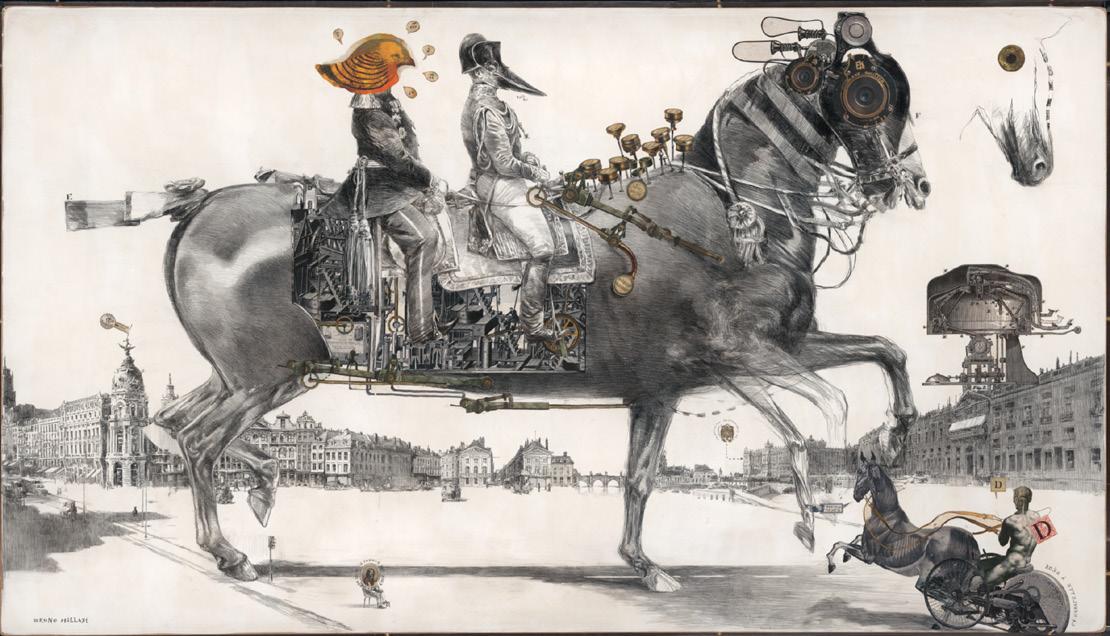
12 minute read
MALLART Bruno
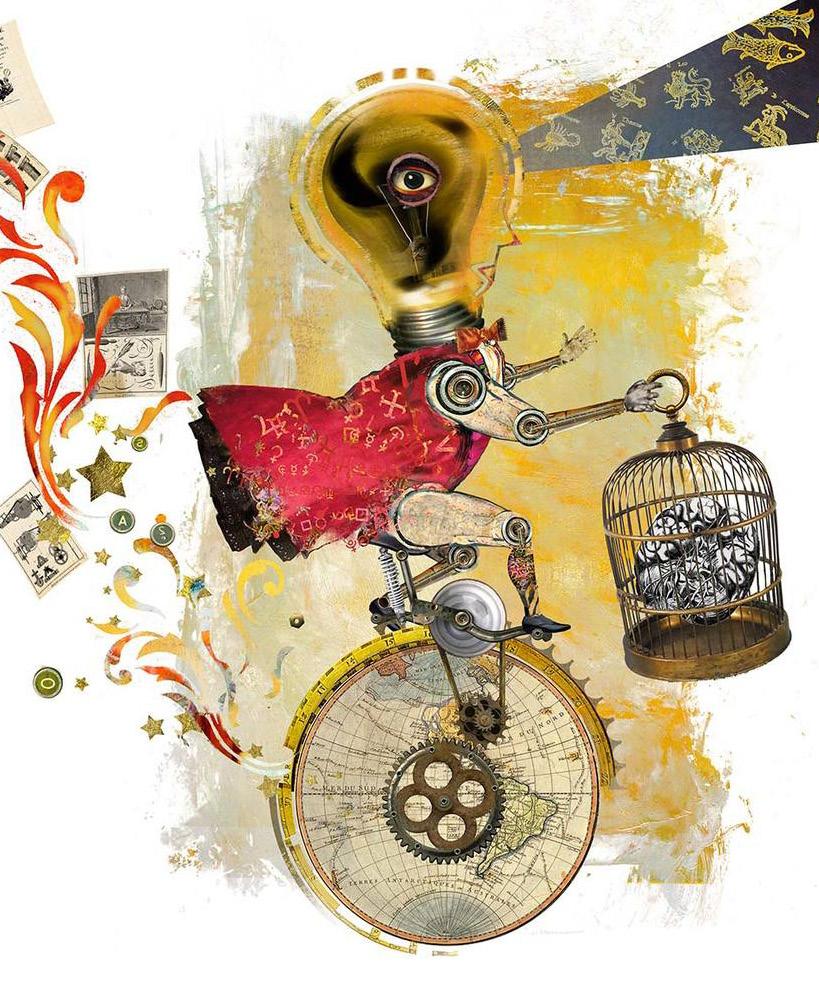

Advertisement
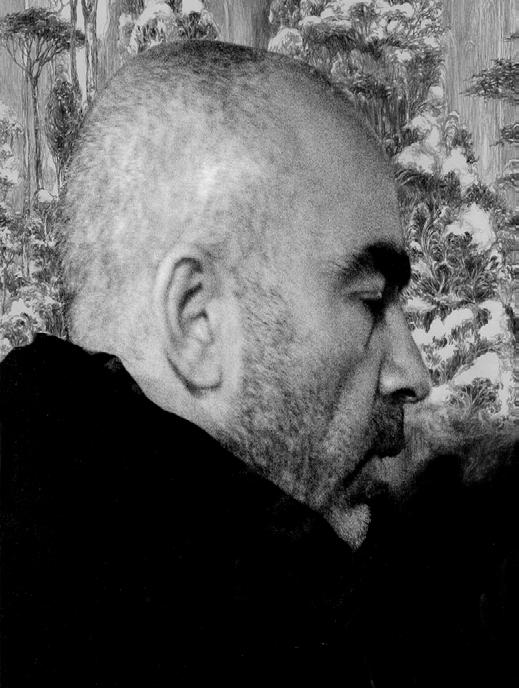
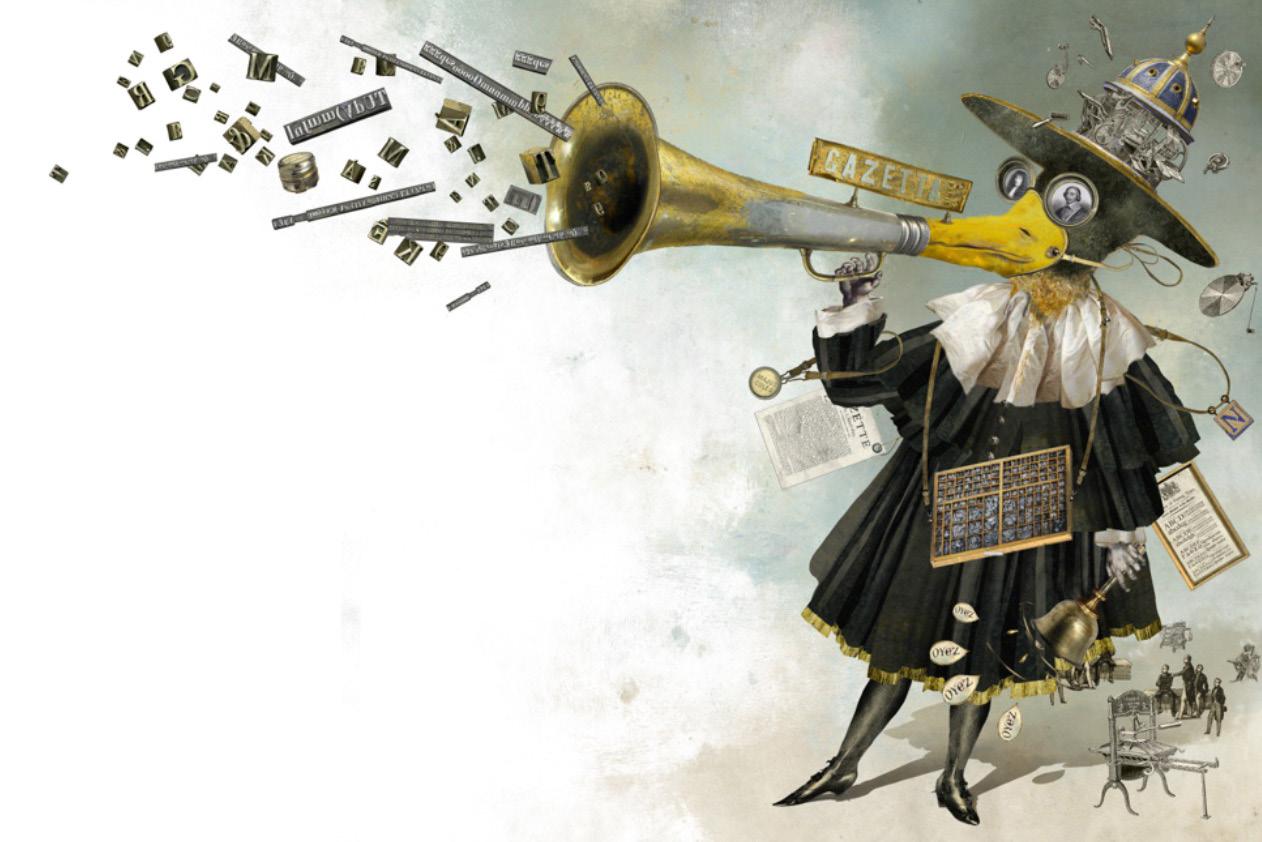
Every now and then I come cross an artist who blows my mind. I literally feel like I'm an art archaeologist who has unearth a great talent whom I had no idea existed. Bruno Mallart is that artist. His vision and execution are superior and it makes me feel honored to have his interview in our magazine. During the process of asking Bruno questions I realized a translation may not capture the full meaning of his answers and because we are read by artists around the globe I decided to print his answers in English and French - editor
When did you first think about art as something you wanted to do? Were you encouraged or discouraged by family, friends, teachers, mentors?
L’école ça n’était pas mon truc, mais le dessin me réussissait bien. Dans ma famille tout le monde est scientifique, de mes grand parents jusqu’à mes frères. Pourtant mes parents m’ont encouragé et j’ai toujours senti de l’admiration de leur part. Ils étaient vraiment sympas avec cette « petite brebis galeuse qui ne deviendra pas Docteur comme tout le monde ». Je m’imaginais devenir prof de dessin. Il faut dire que de mes yeux d’enfant, vivre du dessin, c’était l’enseigner ou crever la dalle (traduction: mourir de faim). Puis, à sà l’école d’art j’ai découvert l’ampleur infinie des métiers artistiques. School was not my thing, but the drawing worked well. In my family everyone is a scientist, from my grandparents to my brothers. Yet, my parents encouraged me and I have always felt the admiration of them. They were really nice with this "little black sheep who will not become a doctor like everyone else".I imagined myself becoming a drawing teacher. It must be said that with my child's eyes, you teach or "you burst the slab" a French expression that means "starving to death". Then at art school I discovered the infinite scope of artistic crafts.
What kind of kid were you? Where did you grow up? What were your influences?
Je suis né à Paris. J’étais un enfant rêveur, du genre qui ne veut pas grandir. J’ai toujours gardé ce côté là, pas trop sérieux, aimant la facétie.Ma première vrai influence fut un peintre Allemand, Pierre Schmmidiger, qui habitait à côté de chez moi et chez qui je prenais des cours de dessin, je devais avoir 11
ou 12 ans. Je passais des après-midi dans son atelier, il me laissait dessiner ce que je voulais, ensuite il commentait et me parlait beaucoup. D’histoire de l’Art, de perspective, de dessin de presse, de politique… Il avait un livre de Saul Steinberg: "The Passport", ce livre représente l’acte de naissance de mon imaginaire d’illustrateur. I was born in Paris. I was a dreamer, the kind who does not want to grow up. I always kept that side, not too serious, loving the joke. My first real influence was a German painter, Pierre Schmmidiger, who lived next to my house and where I took drawing lessons, I must have been 11 or 12 years old. I spent afternoons in his studio, he let me draw what I wanted, then he commented and spoke to me a lot. From the history of art, perspective, drawing of the press, politics ... He had a book by Saul Steinberg: "The Passport", this book represents the birth certificate of my illustrator imagination. Your style is very unique. Did you work on developing a style or is that what naturally came out of you? Un style, ça vient tout seul. Il y a bien sûr la succession d’oeuvres qu’on a aimé et les rencontres qui nous ont influencé, mais je crois que le style vient surtout de ce qu’on est incapable de faire, en creux. Exemple: je ne suis pas bon coloriste: je privilégie le dessin. Je ne suis pas bon portraitiste: je vais remplacer les têtes par des objets…
A style, it comes alone. There is of course the succession of works that we liked and the meetings that influenced us, but I think that the style comes mainly from what we are unable to do, hollow. Example: I am not good colorist: I prefer drawing. I am not a good portraitist: I will replace the heads with objects …
You do a lot of whimsical art. How did that happen?
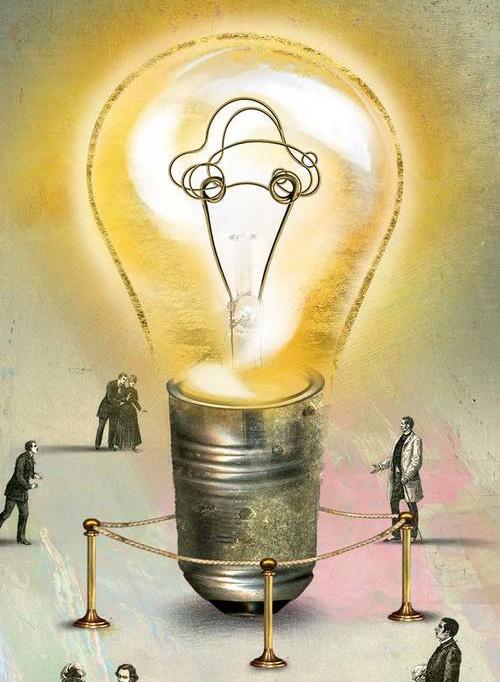
Je ne sais pas, les univers que je représente n’existent pas, mais puisque le dessin me permet de les représenter, pourquoi ne pas le faire? Quand je cherche des idées,
j’essaye de trouver des situations loufoques, absurdes. Paradoxalement,il y a un certain ordre dans mes compositions.
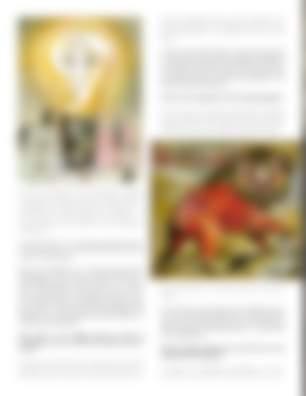
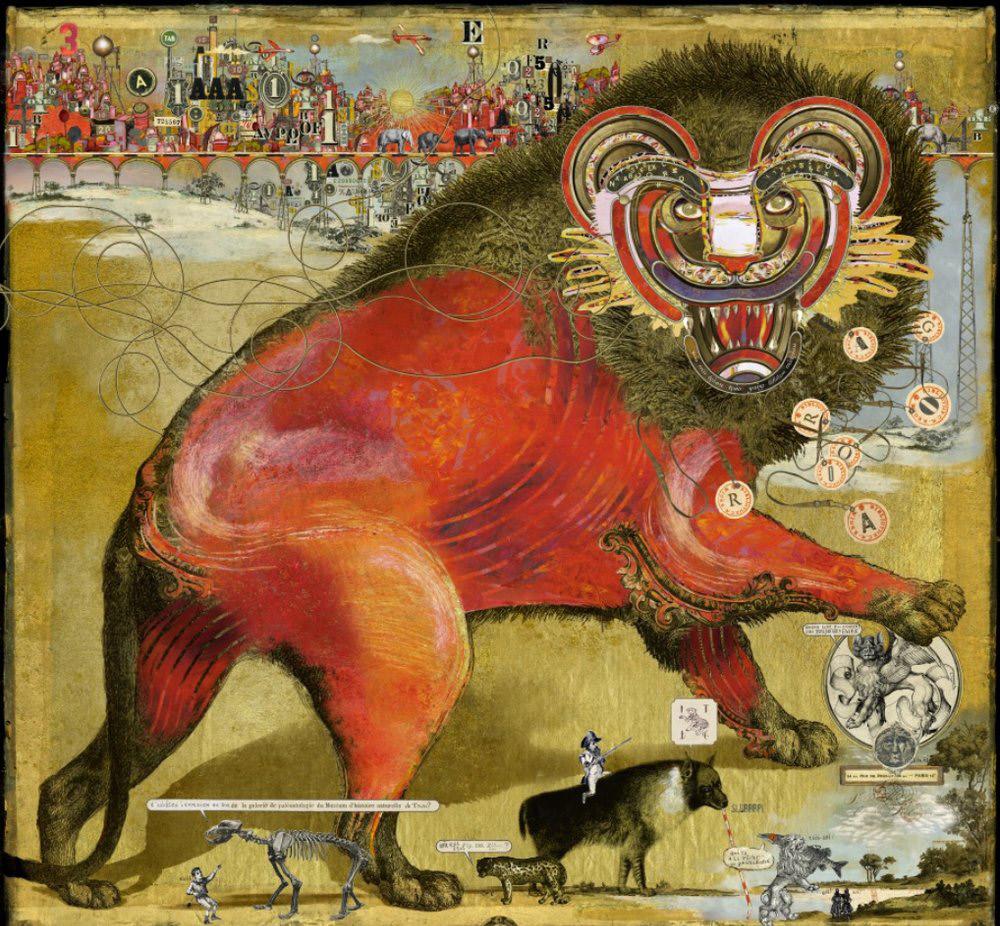
I do not know, the universes that I represent do not exist, but since the drawing allows me to represent them, why not do it? When I look for ideas, I try to find crazy, absurd situations. Paradoxically, there is a certain order in my compositions.
Has the computer affected your work? Do you work traditionally and digitally?
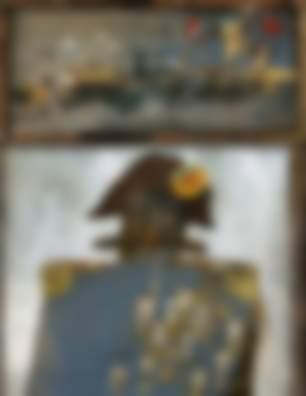
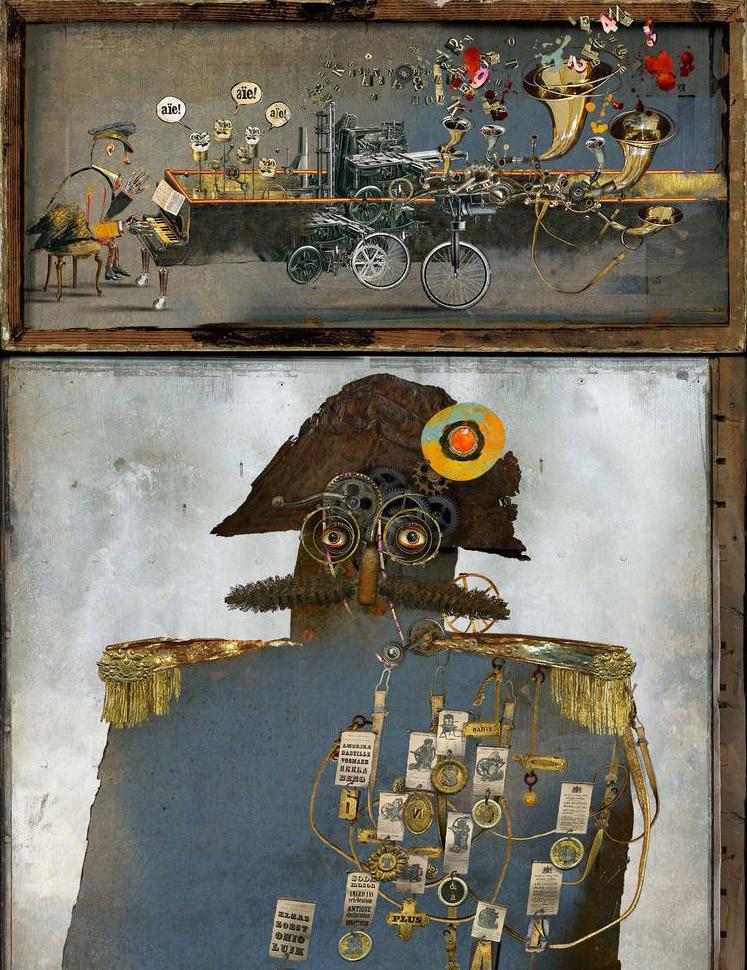
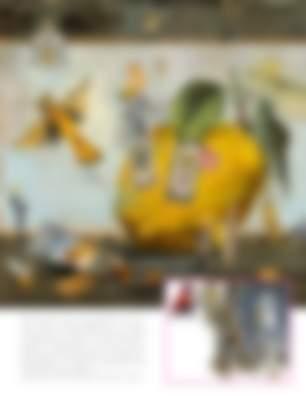
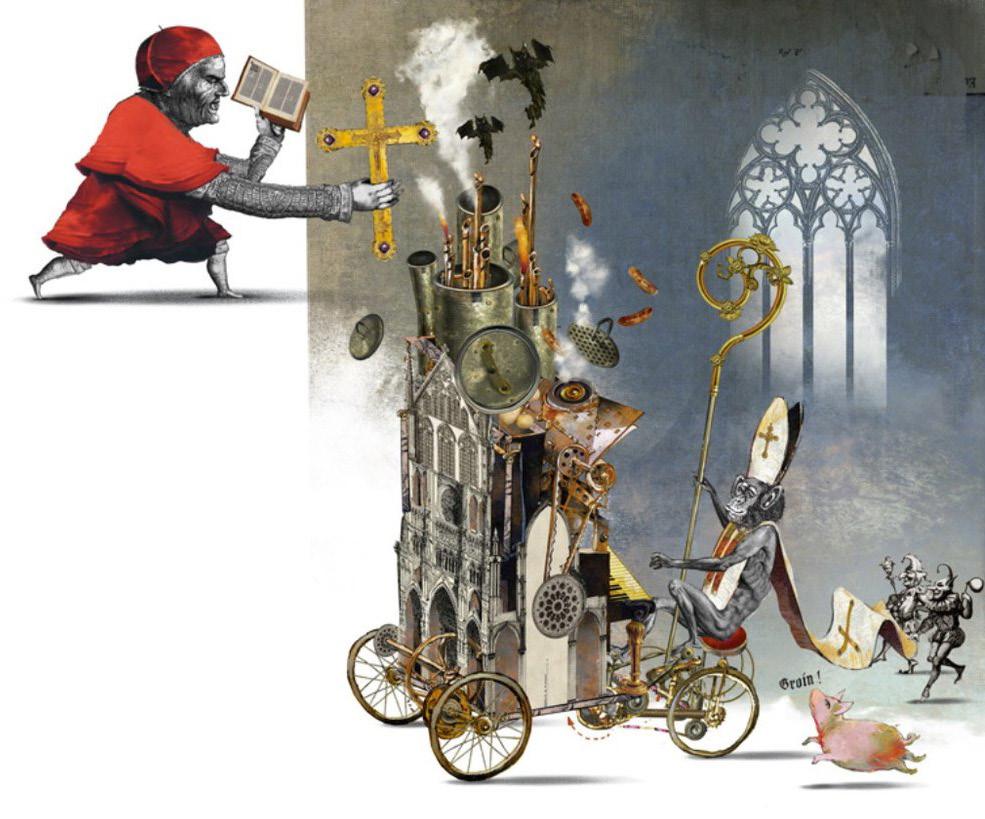
chercher dans les livres de quoi alimenter mes créations. Celles-ci étaient conditionnées à ce que je trouvais. Dans les années 2000, je me suis acheté un ordinateur et un scanner. Je voulais juste pouvoir remplacer la photocopieuse et le fax. Je ne m’attendais pas à découvrir un outil de création qui me plairait autant. Avec Photoshop, les possibilités de transformation des images sont telles que j’avais trouvé l’outil qui me manquait. Aujourd’hui je reviens au dessin traditionnel (toujours.
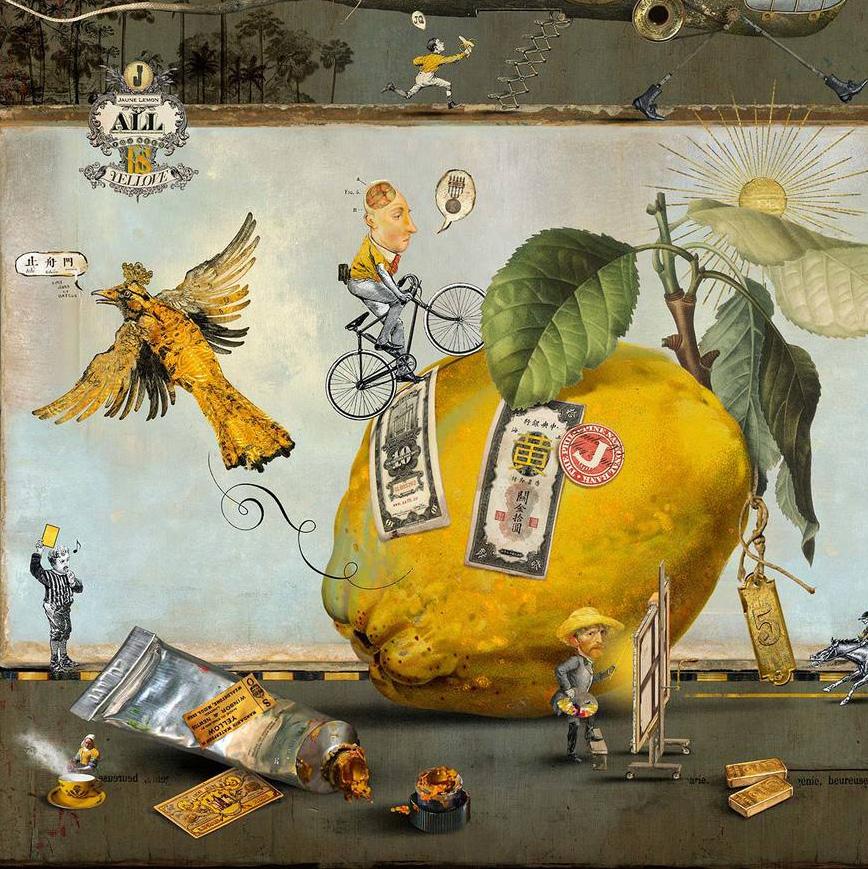
I was doing illustrations mixing drawing, watercolor and a lot of collage. I spent my life looking in books for feeding my creations. These were conditioned to what I found. In the 2000s, I bought a computer and a scanner. I just wanted to be able to replace the photocopier and fax. I did not expect to discover a creative tool that I would like. With Photoshop, the possibilities for transforming images are such that I found the tool I missed. Today I come back to traditional drawing (always a little collage!). The physical support I missed a little. What’s going on in your head when you work on a piece? Your fears, anticipation, confidence , etc. How do you know something is finished?
Il y a plusieurs étapes dans la création d’un des sin:
— L’inspiration, la recherche des idées, c’est le plus agréable et le plus facile psychologiquement. C’est une gymnastique intellectuelle très plaisante, avec les petits croquis sans enjeu, C’est mon étape préférée. — Le démarrage de la réalisation, c’est le plus difficile. Comme l’angoisse de la page blanche chez l’écrivain. C’est à ce moment que je procrastine à mort. — La réalisation proprement dite: alternativement grand plaisir, impression d’être un nul absolu, exaltation, déprime… Bref on ne s’ennuie pas. — Le dessin est fini: quand on est content, qu’on en a marre, on est fatigué et on voudrait passer à autre chose.
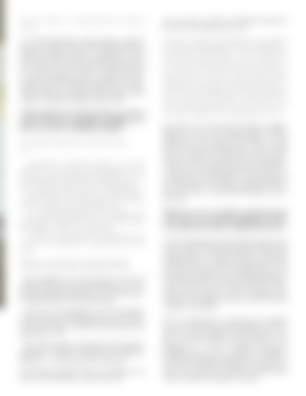
There are several steps in creating a drawing: - The inspiration, the search for ideas, is the most pleasant and the easiest psychologically. It is a very pleasant intellectual gymnastics, with small sketches without stake, It is my favorite stage. - The start of the realization is the most difficult. Like the anxiety of the blank page for a writer. That's when I procrastinate "to death" (a French expression that means " a lot "
- The actual realization: alternatively great pleasure, impression of being an absolute null, exaltation, depressed ... In short one does not get bored.
Are you aware of America and English illustrators? Does their work influence your work? Ma culture vient beaucoup d’illustrateurs ou graphistes tels que Saul Steinberg, Ralph Steadman, Milton Glaser, Tomi Ungerer, André François… pas tous Américains, mais tous une histoire particulière avec les États-Unis. C’est surtout un attachement à une période précise: les années 50, 60, 70. Je suis né en 1963, c’est ma culture. Un peu comme si je disais que j’aime Bob Dylan ou les Pink Floyd. À une époque, je démarchais les agents sur Paris où j’habite, une réflexion que j’entendais régulièrement: "vous devriez démarcher aux états-Unis, votre écriture devrait plaire là-bas". C’est ce que j’ai fait, j’ai ainsi rejoint l’équipe de David Goldman à New-York. My culture comes from many illustrators or graphic designers such as Saul Steinberg, Ralph Steadman, Milton Glaser, Tomi Ungerer, André François ... not all Americans, but all a particular story with the United States. It is especially an attachment to a precise period: the years 50, 60, 70. I was born in 1963, it is my culture. A bit like I said that I like Bob Dylan or the Pink Floyd. At one time, I was walking agents in Paris where I live, a reflection that I heard regularly: "you should approach the United States, your writing should please there." That's what I did, so I joined David Goldman's team in New York. What do you do to promote yourself and get work? Have you worked for publishers in Western counties like America, England and France?
J’ai un site internet qui est une vitrine de tout ce que je fais, ainsi qu’une page Facebook qui publie mon actualité. Mais c’est surtout la galerie, et mon agent d’illustration qui s’occupent de me promouvoir. Il le font bien mieux que moi. J’ai publié dans pas mal de journaux Américains dont le Washington post et le New York times. Je ne fais plus du tout d’illustration de livres comme j’ai fait à une époque, mais j’aimerais bien publier un beau livre, faire un recueil d’images sur un thème. I have a website that is a showcase for everything I do, and a Facebook page that publishes my news. But it's mostly the gallery, and my illustrator, who take care of me. They do it better than me. I've published in a lot of American newspapers including Washington Post and New York Times. I do not do any more book illustration as I did at one time, but I would like to publish a beautiful book, make a collection of images on a theme.
I’m curious about how you choose what to work on. What’s does your process entail? Start to finish. Can you give us a short step-by-step?
Quand je travaille sur une illustration, c’est pas compliqué, Il s’agit de bien répondre à la commande. Mais je fais de plus en plus de créations personnelles montrées en galerie (Je suis représenté par la galerie Bayart à Paris). Le plus compliqué est de choisir quoi faire, il y a tellement de directions possibles!
Le plus amusant c’est que plus on fait de choses, plus le champs des possibles s’élargit. Une sorte d’épidémie: une idée en amène une autre qui elle même en amène 2, puis 4 puis 8… C’est démoralisant et excitant! Si je parle d’un de mes dessins sur bois enduit comme je fais en ce moment, voici comment ça se passe: Je fais un 1er dessin au crayon sur papier. Je scanne le dessin et je le transforme à l’ordinateur pour l’améliorer, je m’aide de collages à partir de gravures anciennes principalement. Le mélange entre dessin et collage est souvent imperceptible.
À ce moment toute la composition est parfaitement aboutie et je vais la projeter en grand sur un panneau de bois enduit blanc. Je sais exactement quelle partie va être dessinée, quelle partie va être en collage, il n’y a plus aucune surprise.
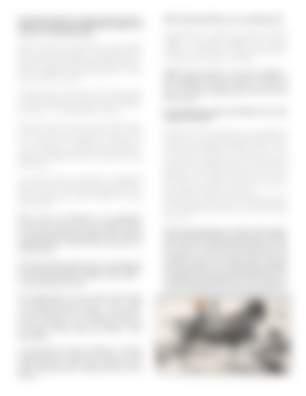
When I work on an illustration, it's not complicated, you just need to answer well to the assignment. But I do more and more personal creations shown in gallery (I am represented by Bayart Gallery in Paris). The most complicated thing is to choose what to do, there are so many directions!
The most fun thing is that the more we do things, the more the field of possibilities expands. A kind of epidemic: an idea brings another who brings 2, then 4 and 8 ... It's demoralizing and exciting! If I'm talking about one of my coated wood drawings as I'm doing right now, here's how it goes: I make a first drawing in pencil on paper. I scan the drawing and I transform it to the computer to improve it, I help with collages from old engravings mainly. The mixture between drawing and collage is often imperceptible.
At this moment the whole composition is perfectly accomplished and I will project it in large on a white coated wood panel. I know exactly which part will be drawn, which part will be in collage, there are no more surprises. En travaillant avec la galerie, j’ai rencontré plusieurs sculpteurs, j’avais toujours imaginé faire un peu de sculpture. J’ai commencé timidement, mais j’aimerais continuer. J’ai plein d’idées, c’est plutôt la mise en oeuvre technique et le temps qui me freinent. Working with the gallery, I met several sculptors, I always imagined doing a little sculpture. I started shyly, but I would like to continue. I have lots of ideas, it's rather the technical implementation and the time that slows me down.
If you could meet anyone in the field you’re in who would it be and why?
Peu après être sorti de l’école d’art, j’avais obtenu un rendez-vous avec le célèbre Illustrateur André François (l’oncle d’un ami habitait le même petit village et le connaissait bien). C’était déjà un monstre sacré, il y avait eu une grande rétrospective de son travail à Paris peu avant. Il m’a reçu gentiment dans son atelier qui était gigantesque. Je lui montrais mon book, ce fut une vraie déconvenue. Il ne comprit pas mon travail et ne savait pas trop quoi me dire. Moi je voulais qu’il me parle de lui, me montre ses tableaux en cours etc… Heureusement l’oncle de l’ami me consola en me disant qu’il ne partageait pas du tout l’avis d’André françois, et qu’il voyait tout à fait l’intérêt de ce que j’avais montré (moi aussi!)
Shortly after graduating from art school, I had an appointment with the famous Illustrator André François (a friend's uncle lived in the same little village and knew him well). It was already a sacred monster, there had been a great retrospective of his work in Paris shortly before. He received me kindly in his workshop which was gigantic I showed him my book, it was a real disappointment. He did not understand my job and did not know what to say to me. I wanted him to talk about him, show me his paintings in class etc...Fortunately the uncle of my friend consoled me
